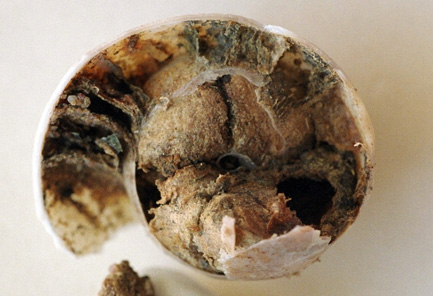Genus Wainia
Nest of Wainia (Caposmia) atrorufa from South Africa in a shell of Trigonephrus; the space between the outermost cell partition and the nest closure (removed) consists of a succession of partitions built from large petal pieces. Foto S. Gess.
Biogeography and diversity
The genus Wainia is distributed in the Afrotropical, the Palaearctic and marginally also in the Oriental region (Michener, 2007; Ungricht et al., 2008).
Currently, there are 11 described Wainia species worldwide, 2 of which occur in the Palaearctic. Probably 1 Palaearctic species is still undescribed (Gess and Gess, 2008; A. Müller, unpublished).
Phylogeny and classification
The genus Wainia is a member of the Osmia group and sister to the clade Atoposmia+Ashmeadiella+Osmia+Hoplosmia (Praz et al., 2008b). Wainia is subdivided into three subgenera (Michener, 2000, 2007), two of which occur in the Palaearctic:
Caposmia with 2 described Palaearctic species
Wainiella with 1 probably undescribed Palaearctic species
Nesting biology
Information on the nesting biology is available for four Afrotropical and one Palaearctic Wainia species of the subgenus Caposmia (Kuhlmann et al., 2011; Müller et al., 2018). All five species were observed to nest in empty snail shells and to build one to several brood cells per shell. In three species, the cell partitions are constructed from several layers of large pieces of yellow-coloured petals (e.g. from Grielum or Asteroideae); the space in front of the outermost cell consists of a succession of partitions built from large petal pieces followed by the nest closure, which – depending on the species – consists of leaf pulp alone or of a mixture of leaf pulp and cemented sand. In Wainia elizabethae, cell partitions and the single-walled nest plug consist of sand grains cemented together with a resinous or, more probably, salivary substance; the space between the outermost cell partition and the nest plug is filled with loose sand. (Gess and Gess, 1990, 1998, 1999, 2008; Kuhlmann et al. 2011; Müller et al., 2018; S. Gess, personal communication).
Flower preferences
The two Palaearctic W. (Caposmia) species have a strong affiliation to the Asteraceae, particularly to the Asteroideae and to a lesser extent also to the Carduoideae (Müller et al., 2018). However, neither species is strictly oligolectic on Asteraceae.
